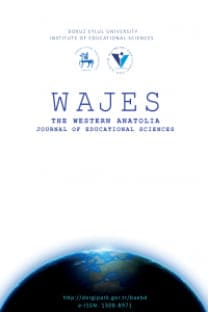Fen ve Sosyal Bilimler Öğretmen Adaylarının Atom Kavramını Açıklamarında “Aminism” ve “Anthropomorphism” Kapsamında Nicel Olarak Karşılaştırılması
Bu araştırmada; fen
bilgisi ve sosyal bilgiler öğretmen adaylarının atom kavramına ilişkin
bilgilerinin ve günlük yaşamda dilsel olarak kullanım ifadelerinin "insana
özgül dil (öznellik=animism)" ve "canlılık (nesnellik= anthropomorphism)" özellikleri kapsamında nicel olarak
karşılaştırılması amaçlanmıştır. Araştırma, 2014-2015 eğitim yılında fen
bilgisi ve sosyal bilgisi öğretmen adaylarının katılımıyla yapılmıştır. Araştırmada nicel araştırma yöntemlerinden
betimsel tarama tekniği kullanılmıştır. Veriler, Nakiboğlu ve Poyraz'ın (2006)
ve Taber’in (1996) yaptığı araştırmaların yöntem ve bulgularına dayandırılarak
oluşturulan altı seçenekli 25 maddelik bir ölçme aracıyla toplanmıştır. Altı
seçeneğin üçü antropomorfizm; diğer üçü animizmle ilgilidir. Test maddeleri, cümlede
yüklem yerlerinin boş bırakıldığı bilimsel önerme cümlelerinden oluşmaktadır.
Bu ölçme aracında, öğrencilerden 6 seçenekten kendilerine uygun olan ilk üç
seçeneği sıralamaları istenmiştir. Sonuç olarak, fen bilgisi ve sosyal bilgiler
öğretmen adaylarının atom kavramlarını “insana özgü dil (animism) ” ve “canlılık (anthropomorphism)” ölçütüne göre
açıklamaları karşılaştırıldığında, fen öğretmen adaylarının
"canlılığı", sosyal öğretmen adaylarının ise "insana özgü
dil" kullanımı tercih ettikleri görülmüştür. Böyle bir farklılığın
öğrencilerin konuya olan ilgi ve bilgi düzeylerinden kaynaklandığı
düşünülmektedir. Cinsiyet çeşitliliği göz önüne alındığında, erkek ve kız
öğrenciler arasında neredeyse hiç fark bulunmadığı ortaya çıkmıştır.
Anahtar Kelimeler:
İnsana Özgül Dil (Animizm), Canlılık (Antropomorfizm), Atom kavramı
Qualitative Comparison According To Animism And Anthropomorphism Of Social And Science Pre-Service Teachers' Explanations Towards Atomic Concept
In research, the aim is to compare quantitatively the knowledge related to
the concept of atoms by the Pre-Service Teachers (PST) in science and social
studies to the daily use of the terms animism and anthropomorphism
linguistically. This research was done with the contribution of the students
who studied sociology, history, philosophy, in social studies and the ones who
studied at science teaching fields in 2014-2015 academic year. In this research
descriptive research technique, which is one of the methods of quantitative
research technique used. The data collection instrument of this research: A
quantitative measuring instrument was developed by deriving the data as a
result of the researchers by Nakipoğlu, Poyraz (2006) and Taber (1996). This
measuring instrument (2006) consists of 25 items. Each item covers 6 choices.
Three of these choices are about anthropomorphism; the other three choices are
about animism. The test items consist of scientific propositions
in which the verb places are left empty in the sentence. Students are asked to identify the first three sentences which are true
for them. The frequent use of the two terms: subjectivity and objectivity are
compared according to the field and gender variety. The students who are at the
social department use subjective expressions more than the students at the
science department. When gender variety has been considered, it has been put
forth that there has been nearly no difference between male and female
students.
Keywords:
Animism, Anthropomorphism, Atomic Concept,
___
- Banister, F. and Ryan, C. (2001). Developing Science Concepts through Story-Telling. School Science Review, 83 (302), p.75-83.
- Budak, Y. (2000). Sözcük Öğretimi ve Sözlüğün İşlevi. Dil Dergisi, p.92.
- Cohen, L., Manion, L. and Morrison, K. (2007). Research Methods in Education. London: Routhledge.
- Dorion, K.(2011). A learner’s tactic: How secondary students’ anthropomorphic language may support learning of abstract science concepts, Electronic Journal of Science Education, 12(2).
- Erdener, E. (2009). The Arguments of Vygotsky on Thought and Language: A Critical View To Piaget. Turkish Journal of Education. 7(1), p.85-103.
- Gilbert, J., Watts, D. and Osborne, R. (1982), Students' conceptions of ideas in mechanics. Physics Education, 17, p.62-66.
- Hellden, G. (2005). Exploring understandings and responses to science: a program of longitudinal studies. Research in Science Education, 35, 99-122.
- Jungwirth, E.. (1975). Caveat Mentor: Let the Teacher Beware!. Research in Science Education. 5(1), p.153-160.
- Kallery, M. and Psillos, D. (2004). Anthropomorphism and Animism in Early Years Science: Why Teachers Use Them, How Conceptualise Them and What Are Their Views on Their Use. Research in Science Education, 34, p.291-311.
- Karasar, N. (2005). Scientific Research Methods (15. Press). Ankara (Turkey): Nobel Publisher distribution.
- Looft, W. R. and Bartz, H. (1969). Animism revived. Psychological Bulletin, 71(1), p.1–19.
- Laurendeau, M. and Pinard, A. (1962). Causal thinking in the child. International Universities Press, Montreal.
- McCoy, M. (2003). Systematic Misrepresentation: Analogy and Anthropomorphism in the Work of Charles and Erasmus Darwin, Discourse, 9. McMillan, J.H. and Schumacher, S. (2001). Research in Education: A Conceptual Introduction. New York: Longman
- Nakiboğlu,C. and Poyraz,H.E. (2006). Investigation of “Anthropomorphism” And “Animism” In University Chemistry Students’ Explanations Related to Atom and Chemical Bonding, Kastamonu Eğitim Dergisi,14 (1), s.83-90.
- Nicoll, G. (2001). A Report of Undergraduates’ bonding Misconceptions. International Journal of Science Education, 23 (7), p.707-730.
- Özdemir, O. (2012). Science and Technology Pre-Service Teachers’ Tendencies to Explain Vitality. Educational Sciences: Theory & Practice, 12(4).
- Pyburn D. T., Pazicni S., Benassi V. A. and Tappin E. E. (2013). Assessing the relation between language comprehension and performance in general chemistry. Chem. Educ. Res. Pract., 14(4), p.524–541, OI: 10.1039/ C3RP00014A.
- Treagust, D. F., Chittleborough, G. & Thapelo, L.M. (2003). The Role of Submisroscopic and Symbolic Representations in Chemical Explanations. International Journal of Science Education, 25 (11), p.1353-1368.
- Taber, K.S. and Watts, M. (1996). The secret life of the chemical bond: Students’ anthropomorphic and animistic references to bonding. International Journal of Science Education, 18(5), p.557–568.
- Taber, K.S. (2015), Exploring the language(s) of chemistry education. Chem. Educ. Res. Pract., 16,p.193-197, DOI: 10.1039/c5rp90003d.
- Tamir, P. and Zohar, A. (1991). Anthropomorphism and Teleology in Reasoning about Biological Phenomena. Science Education, 74(1), p.57-67.
- Watts, M. and Bentley, D. (1994). Humanizing and feminizing school science: reviving anthropomorphic and animistic thinking in constructivist science education,. International Science Education, 16(1), 83-97.
- Yağbasan, R. and Gülçicek, Ç. (2003). Describing the characteristics of misconceptions in science teaching. Pamukkale University Journal of Education, 13(1).
- Zohar A. & Ginossar, S. (1998). Lifting the taboo regarding teleology and anthropomorphism in biology education - heretical suggestions. Science Education, 82 (6), p.679-697.
- Yayın Aralığı: Yılda 2 Sayı
- Başlangıç: 2010
- Yayıncı: Dokuz Eylül Üniversitesi
